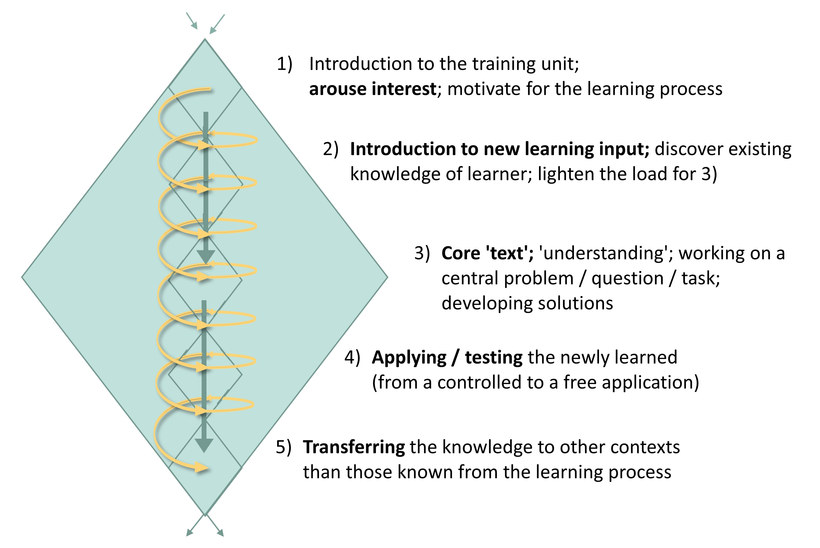When viewed from the perspective of constructivist learning theories, it is logical to understand teaching “as the science of forming and shaping " (Baumgartner & Bergner, 2014, p. 164). It is about designing learning processes in such a way that they are on the one hand consistently structured, but on the other hand offer the learners as much freedom as possible for their own self-development. The challenge lies in structuring the learning process in such a way that it is provides motivating and sustainable learning, while at the same time allowing the structure to recede behind the dynamics of the learning process, unnoticed by the learner.
The structuring of teaching or training sequences make use of appropriate ‘phase and structure’ models. There are a large number of such models, which differ in detail, but basically follow a similar structuring scheme to the one below:
The Didactic Diamond
Source: Bolten, 2007b, p. 100. Graphic recreated by Vera Harder
Click on the image for a larger view
1. Arousing interest in the topic
At the beginning of a learning unit, learners have to be picked up where they are at that moment in terms of their previous knowledge and experience, but also in terms of their attitude towards the learning scenario.
The first phase is about opening learners up to the learning process, establishing connection points to what has already been learned and building a bridge to the subsequent learning steps. Open questions, association exercises, a mind map on the topic or a quiz are suitable for this.
It is important to note that connections/references are also made to previous learning units.
2. Introduction of new learning content that is important for processing the question/topic
This phase is about establishing a common starting point to build new knowledge and new experiences with the intention of preparing the next step towards the learning goal. The focus is initially on becoming familiar with the new materials.
The introduction of new learning content should always be considered in terms of the goal. What is important here is the content that is logically necessary to solve the corresponding problem or task. Open questions, class discussions, lectures, educasts, texts and images can support the learning process.
It is important to note that ‘input’ is only provided to the extent that digesting of information can take place. Content should always be targeted and not presented for its own sake.
3. Processing of the question or topic (core text
If the learning content is selected according to a specific sub-goal, the associated question or task should be solvable in this context. The goal should be to enable an analysis, which focuses on the understanding of a topic that is central to the teaching/learning sequence (based on the experience and knowledge gained in the previous, preparatory learning phase). Ultimately, this step is about being able to check whether the new learning content has really been understood.
Only under the condition that the tasks are solvable will it be possible to maintain the learner's motivation or even increase it. Processing the content is at the heart of the teaching and learning sequence. Core texts in intercultural teaching and training sequences can consist of classic text types as well as games, films or film excerpts, pictures, scenic representations, noises, etc. It is always a matter of choosing learning material, which when processed/analysed/understood, automatically fulfils the learning goal for that phase. Working with core texts could involve reflections and group discussions on a case study text, interpretations of images or graphics, cinematic or scenic representations. It could consist of working on tasks related to the questions or problems presented.
It is important to note that the core texts should be small in length so as not to inhibit the dynamics of the learning process through longer periods of silent work.
4. (Guided) application / testing of what has been learned or worked on
Holistic and sustainable learning requires the enabling of learning in the sense of intake (rather than input), i.e., enabling a docking process with previous knowledge. This essentially only happens through the application and testing of what has been learned (learning by doing). Therefore, this entails the independent application of what has been learned and the development of learners’ own solutions.
The application phase can be implemented using interactive methods or through experimental, action-oriented exercise forms.
It is important here not to take the step towards independent, unguided application too quickly.
5. Summary: Transfer of what has been learned to subject areas other than those worked on (independent application)
In the fifth, final learning phase, the aim is that learners are able to independently apply the skills acquired in the previous learning phases (one to four) in contexts other than those already familiar to them. This only works if learners manage to transfer what has been learned into unknown and unfamiliar contexts. Unguided collaborative work or intercultural project work can be methods to support this learning phase.
It is important to note that the trainer should take a back seat here and perform only moderation tasks. (Bolten, 2020)
This way of structuring comes from Hans Aebli (2011) and builds on Dewey's (1910) theory of cognition.
Bolten (2007b) illustrates the interaction of the five learning phases using the figure of a diamond, i.e. a didactic diamond. "The learning process is ideally based on a core task (3), which is prepared step by step until either a full understanding or a solution is achieved (1) (2). The sustainability of the learning process is achieved through an application phase, which is to some extent controlled (4) and an unguided transfer phase (5), which encourages independent action. Ideally, the training sequence itself builds on previous learning processes and prepares subsequent ones. This results in a learning spiral – or, to stay with the metaphor: a diamond spiral." (Bolten, 2007b, translated)
